2018 RENAULT SCENIC tow bar
[x] Cancel search: tow barPage 217 of 364
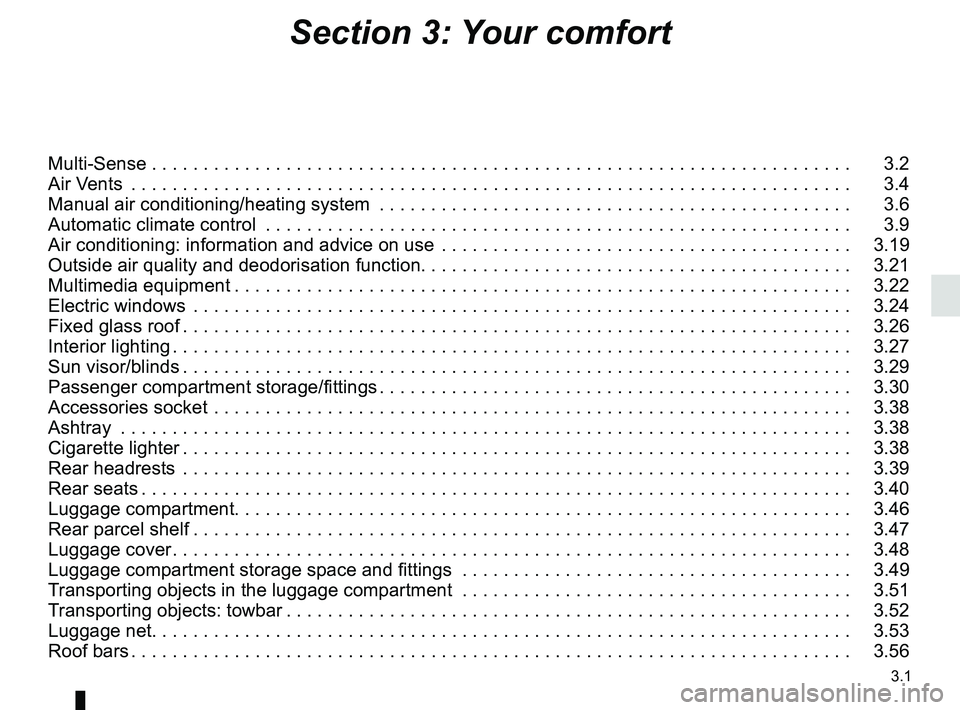
3.1
Section 3: Your comfort
Multi-Sense . . . . . . . . . . . . . . . . . . . . . . . . . . . . . . . . . . . .\
. . . . . . . . . . . . . . . . . . . . . . . . . . . . . . . . 3.2
Air Vents . . . . . . . . . . . . . . . . . . . . . . . . . . . . . . . . . . . .\
. . . . . . . . . . . . . . . . . . . . . . . . . . . . . . . . . . 3.4
Manual air conditioning/heating system . . . . . . . . . . . . . . . . . . . . . . . . . . . . . . . . . . . .\
. . . . . . . . . . 3.6
Automatic climate control . . . . . . . . . . . . . . . . . . . . . . . . . . . . . . . . . . . .\
. . . . . . . . . . . . . . . . . . . . . 3.9
Air conditioning: information and advice on use . . . . . . . . . . . . . . . . . . . . . . . . . . . . . . . . . . . .\
. . . . 3.19
Outside air quality and deodorisation function. . . . . . . . . . . . . . . . . . . . . . . . . . . . . . . . . . . . \
. . . . . . 3.21
Multimedia equipment . . . . . . . . . . . . . . . . . . . . . . . . . . . . . . . . . . . . \
. . . . . . . . . . . . . . . . . . . . . . . . 3.22
Electric windows . . . . . . . . . . . . . . . . . . . . . . . . . . . . . . . . . . . .\
. . . . . . . . . . . . . . . . . . . . . . . . . . . . 3.24
Fixed glass roof . . . . . . . . . . . . . . . . . . . . . . . . . . . . . . . . . . . . \
. . . . . . . . . . . . . . . . . . . . . . . . . . . . . 3.26
Interior lighting . . . . . . . . . . . . . . . . . . . . . . . . . . . . . . . . . . . . \
. . . . . . . . . . . . . . . . . . . . . . . . . . . . . . 3.27
Sun visor/blinds . . . . . . . . . . . . . . . . . . . . . . . . . . . . . . . . . . . . \
. . . . . . . . . . . . . . . . . . . . . . . . . . . . . 3.29
Passenger compartment storage/fittings . . . . . . . . . . . . . . . . . . . . . . . . . . . . . . . . . . . . \
. . . . . . . . . . 3.30
Accessories socket . . . . . . . . . . . . . . . . . . . . . . . . . . . . . . . . . . . .\
. . . . . . . . . . . . . . . . . . . . . . . . . . 3.38
Ashtray . . . . . . . . . . . . . . . . . . . . . . . . . . . . . . . . . . . .\
. . . . . . . . . . . . . . . . . . . . . . . . . . . . . . . . . . . 3.38
Cigarette lighter . . . . . . . . . . . . . . . . . . . . . . . . . . . . . . . . . . . . \
. . . . . . . . . . . . . . . . . . . . . . . . . . . . . 3.38
Rear headrests . . . . . . . . . . . . . . . . . . . . . . . . . . . . . . . . . . . .\
. . . . . . . . . . . . . . . . . . . . . . . . . . . . . 3.39
Rear seats . . . . . . . . . . . . . . . . . . . . . . . . . . . . . . . . . . . . \
. . . . . . . . . . . . . . . . . . . . . . . . . . . . . . . . . 3.40
Luggage compartment. . . . . . . . . . . . . . . . . . . . . . . . . . . . . . . . . . . . \
. . . . . . . . . . . . . . . . . . . . . . . . 3.46
Rear parcel shelf . . . . . . . . . . . . . . . . . . . . . . . . . . . . . . . . . . . . \
. . . . . . . . . . . . . . . . . . . . . . . . . . . . 3.47
Luggage cover . . . . . . . . . . . . . . . . . . . . . . . . . . . . . . . . . . . . \
. . . . . . . . . . . . . . . . . . . . . . . . . . . . . . 3.48
Luggage compartment storage space and fittings . . . . . . . . . . . . . . . . . . . . . . . . . . . . . . . . . . . .\
. . 3.49
Transporting objects in the luggage compartment . . . . . . . . . . . . . . . . . . . . . . . . . . . . . . . . . . . .\
. . 3.51
Transporting objects: towbar . . . . . . . . . . . . . . . . . . . . . . . . . . . . . . . . . . . . \
. . . . . . . . . . . . . . . . . . . 3.52
Luggage net. . . . . . . . . . . . . . . . . . . . . . . . . . . . . . . . . . . . \
. . . . . . . . . . . . . . . . . . . . . . . . . . . . . . . . 3.53
Roof bars . . . . . . . . . . . . . . . . . . . . . . . . . . . . . . . . . . . . \
. . . . . . . . . . . . . . . . . . . . . . . . . . . . . . . . . . 3.56
Page 223 of 364

3.7
MANUAL AIR CONDITIONING (2/3)
Distribution of air in the
passenger compartment
There are five air distribution options.
Turn control 5 to choose the distribution
option.
The air distribution is displayed on the
multimedia screen.
õThe air flow is directed to the
windscreen and the front side
window demisting vents.
÷The air flow is distributed be-
tween all the air vents, the
front side window demisting vents, the
windscreen demisting vents and the
footwells.
óThe air flow is directed mainly
towards the footwells.
GThe air flow is directed towards
the dashboard air vents, the
front footwells and, depending on the
vehicle, the second row footwells.
JAll the air flow is directed to the
dashboard vents.
5
Adjusting the air temperature
Turn control 1 to obtain the desired
temperature. The more bars are dis-
played on the multimedia screen, the
higher the temperature.
When the air conditioning system is
used for long periods, it may begin to
feel cold. To increase the temperature,
turn control 1 to the right.
Rear screen de-icing/
demisting
With the engine running, press the
control 2. The operating tell-tale comes
on.
This function permits rapid demisting/
de-icing of the rear screen and de-icing
of the door mirrors (on equipped vehi-
cles).
To exit this function, press the con-
trol 2 again.
Demisting automatically stops.
21
Page 268 of 364
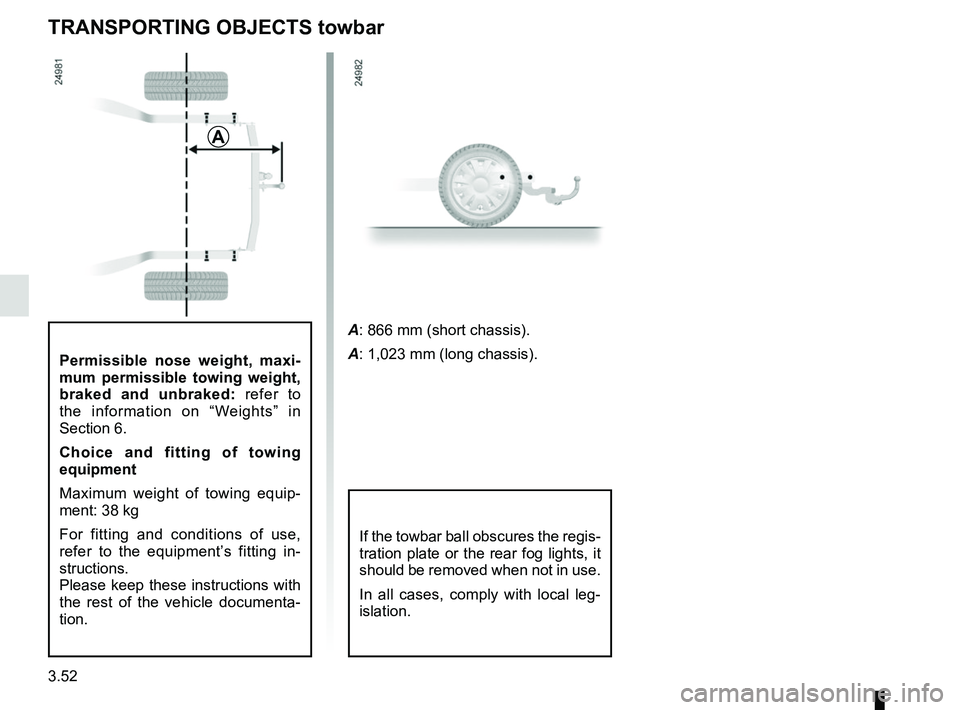
3.52
Permissible nose weight, maxi-
mum permissible towing weight,
braked and unbraked: refer to
the information on “Weights” in
Section 6.
Choice and fitting of towing
equipment
Maximum weight of towing equip-
ment: 38 kg
For fitting and conditions of use,
refer to the equipment’s fitting in-
structions.
Please keep these instructions with
the rest of the vehicle documenta-
tion.
TRANSPORTING OBJECTS towbar
A
A: 866 mm (short chassis).
A: 1,023 mm (long chassis).
If the towbar ball obscures the regis-
tration plate or the rear fog lights, it
should be removed when not in use.
In all cases, comply with local leg-
islation.
Page 285 of 364
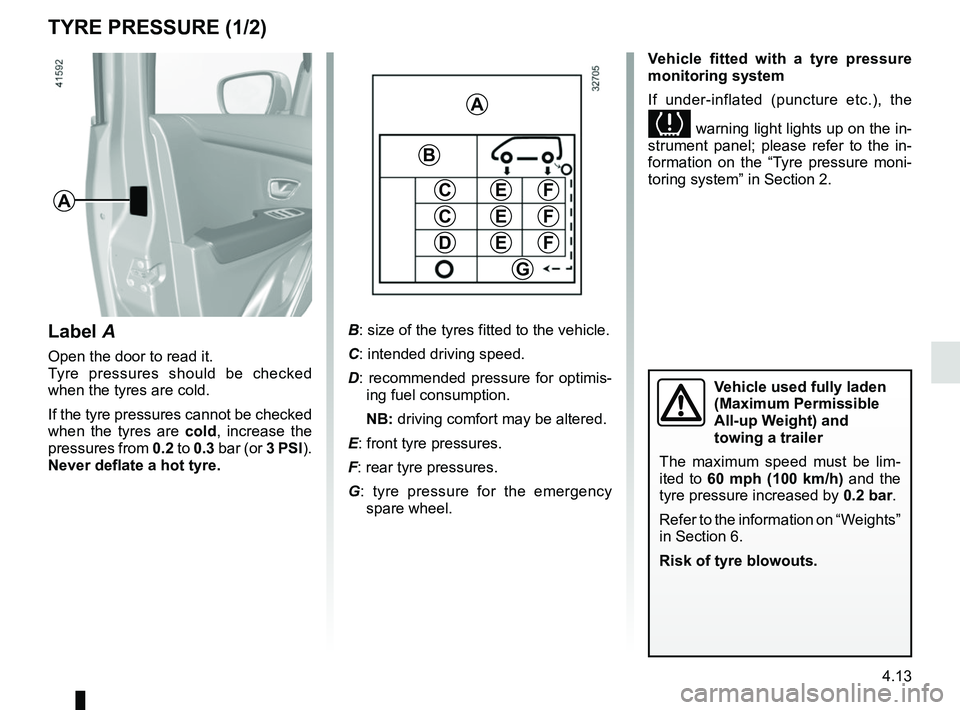
4.13
TYRE PRESSURE (1/2)
A
Label A
Open the door to read it.
Tyre pressures should be checked
when the tyres are cold.
If the tyre pressures cannot be checked
when the tyres are cold, increase the
pressures from 0.2 to 0.3 bar (or 3 PSI).
Never deflate a hot tyre. Vehicle fitted with a tyre pressure
monitoring system
If under-inflated (puncture etc.), the
warning light lights up on the in-
strument panel; please refer to the in-
formation on the “Tyre pressure moni-
toring system” in Section 2.
B: size of the tyres fitted to the vehicle.
C: intended driving speed.
D: recommended pressure for optimis- ing fuel consumption.
NB: driving comfort may be altered.
E: front tyre pressures.
F: rear tyre pressures.
G : tyre pressure for the emergency
spare wheel.
A
C
D
FE
G
B
C
E
E
F
F
Vehicle used fully laden
(Maximum Permissible
All-up Weight) and
towing a trailer
The maximum speed must be lim-
ited to 60 mph (100 km/h) and the
tyre pressure increased by 0.2 bar.
Refer to the information on “Weights”
in Section 6.
Risk of tyre blowouts.
Page 320 of 364

5.28
FUSES (2/2)
Allocation of fuses
(the presence of certain fuses depends on the vehicle equipment level)\
Symbol Allocation SymbolAllocation
HWindscreen washer“Hybrid Assist” system
ëThird row accessories socket, boot accessories
socketÝTowbar socket
ÆFront cigarette lighter, front and rear second row
accessories socketDiagnostic socket, audio alarm
Not usedÌHorn
Heated door mirrorsInstrument panel, dashboard control lighting
×Brake lights, passenger compartment central unitRear electric windows
\bParking brakefFront windscreen wiper
Additional servoDDirection indicator lights, hazard warning lights
îRadio, multifunction screen, multimedia acces-
sories sockets, parking brake controlRear USB sockets on console
Passenger compartment centre unit, rear wiper,
rear fog light
OLocking the doors and luggage compartment
Page 329 of 364
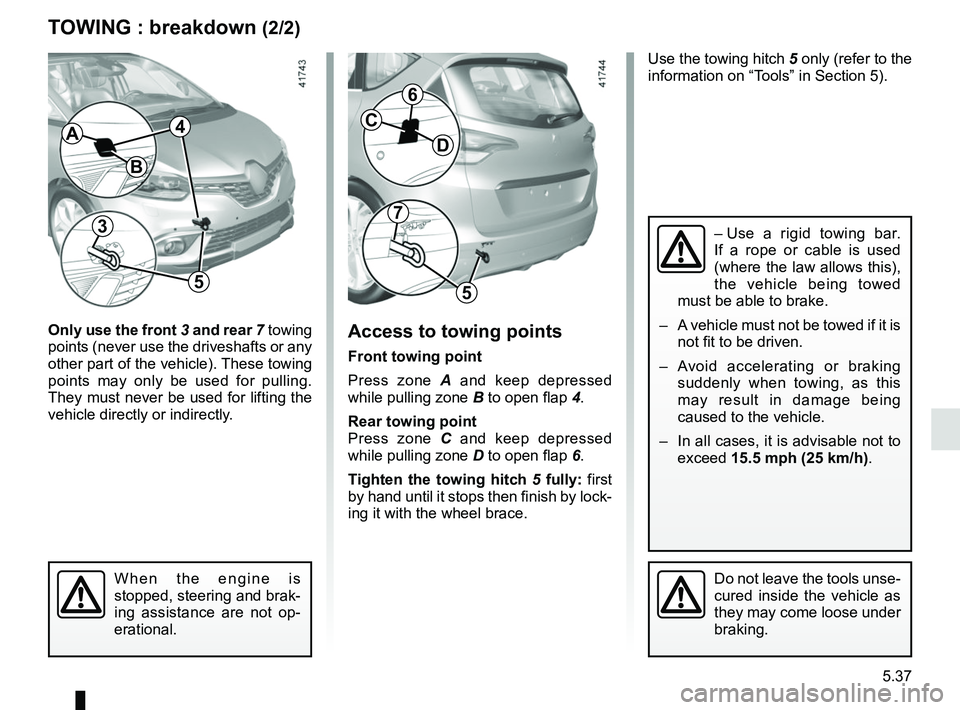
5.37
TOWING : breakdown (2/2)
Only use the front 3 and rear 7 towing
points (never use the driveshafts or any
other part of the vehicle). These towing
points may only be used for pulling.
They must never be used for lifting the
vehicle directly or indirectly.Access to towing points
Front towing point
Press zone A and keep depressed
while pulling zone B to open flap 4.
Rear towing point
Press zone C and keep depressed
while pulling zone D to open flap 6.
Tighten the towing hitch 5 fully: first
by hand until it stops then finish by lock-
ing it with the wheel brace.
Do not leave the tools unse-
cured inside the vehicle as
they may come loose under
braking.
Use the towing hitch 5 only (refer to the
information on “Tools” in Section 5).
B
AC
D
– Use a rigid towing bar.
If a rope or cable is used
(where the law allows this),
the vehicle being towed
must be able to brake.
– A vehicle must not be towed if it is not fit to be driven.
– Avoid accelerating or braking suddenly when towing, as this
may result in damage being
caused to the vehicle.
– In all cases, it is advisable not to exceed 15.5 mph (25 km/h).
When the engine is
stopped, steering and brak-
ing assistance are not op-
erational.
37
55
6
4
Page 343 of 364
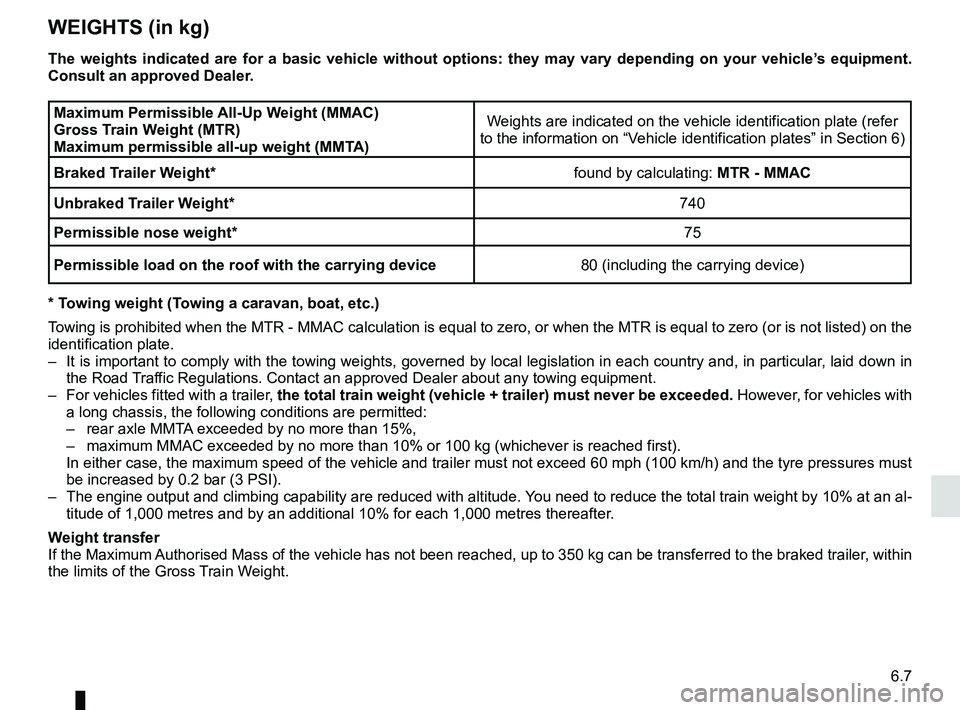
6.7
WEIGHTS (in kg)
The weights indicated are for a basic vehicle without options: they may \
vary depending on your vehicle’s equipment.
Consult an approved Dealer.
Maximum Permissible All-Up Weight (MMAC)
Gross Train Weight (MTR)
Maximum permissible all-up weight (MMTA)Weights are indicated on the vehicle identification plate (refer
to the information on “Vehicle identification plates” in Section 6)
Braked Trailer Weight* found by calculating: MTR - MMAC
Unbraked Trailer Weight* 740
Permissible nose weight* 75
Permissible load on the roof with the carrying device 80 (including the carrying device)
* Towing weight (Towing a caravan, boat, etc.)
Towing is prohibited when the MTR - MMAC calculation is equal to zero, or\
when the MTR is equal to zero (or is not listed) on t he
identification plate.
– It is important to comply with the towing weights, governed by local leg\
islation in each country and, in particular, laid down in the Road Traffic Regulations. Contact an approved Dealer about any towing equipment.
– For vehicles fitted with a trailer, the total train weight (vehicle + trailer) must never be exceeded. However, for vehicles with
a long chassis, the following conditions are permitted:
– rear axle MMTA exceeded by no more than 15%,
– maximum MMAC exceeded by no more than 10% or 100 kg (whichever is reach\
ed first).
In either case, the maximum speed of the vehicle and trailer must not ex\
ceed 60 mph (100 km/h) and the tyre pressures must be increased by 0.2 bar (3 PSI).
– The engine output and climbing capability are reduced with altitude. You need to reduce the total train weight by 10% at an a l-
titude of 1,000 metres and by an additional 10% for each 1,000 metres th\
ereafter.
Weight transfer
If the Maximum Authorised Mass of the vehicle has not been reached, up to 350 kg can be\
transferred to the braked trailer, with in
the limits of the Gross Train Weight.
Page 361 of 364

7.5
ALPHABETICAL INDEX (5/6)
rear view camera .................................................... 2.87 – 2.88
rear view mirrors ..................................................... 1.92 – 1.93
R
remote control card: use ......................................... 1.10 – 1.11
R
remote control door lockingbatteries ..............................................................\
......... 5.32
remote control door locking unit ................................1.2 → 1.4
RENAULT ANTI-INTRUDER DEVICE (RAID) ................... 1.18
RENAULT card battery ................................................................\
.......... 5.31
use ....................................................................\
.1.6 → 1.12
RENAULT card battery ...................................................... 5.31
replacement parts ................................................................ 6.8
reverse gear selecting ..................................................2.20, 2.93 → 2.95
reversing sensor ....................................................2.82 → 2.86
roof bars ........................................................................\
.... 3.56
roof rack roof bars ....................................................................... 3.56
running in .................................................................... 2.2 – 2.3
S
safety distance warning .........................................2.59 → 2.61
safety distances .....................................................2.59 → 2.61
screen fold-away screen .......................................................... 1.74
navigation display .................................. 1.73, 3.22 – 3.23
navigation screen ..................................... 1.73, 3.22 – 3.23
screen wash/wipe ............................................... 1.109 – 1.110
seat belt pretensioners ..........................................1.32 → 1.35
seat belts ................................ 1.28 → 1.30, 1.32 → 1.35, 1.38
see-me-home lighting ........................................................ 1.99
service sheets..........................................................6.9 → 6.14side indicator lights
changing bulbs ............................................................. 5.23
sign detection: overspeed warning ........................2.64 → 2.66
signals and lights .................................................1.95 → 1.102
special features of diesel versions..................................... 2.13
special features of petrol vehicles ..................................... 2.12
speed limiter ..........................................................2.67 → 2.69
starting the engine .....................................................2.3 → 2.7
steering wheel adjustment .............................................................\
...... 1.91
Stop & Start ............................................................. 2.8 → 2.11
Stop & Start function................................................ 2.8 → 2.11
stopping the engine ............................................................. 2.4
storage compartment.............................................3.30 → 3.37
storage compartments ..................................3.30 → 3.37, 3.49
sun blinds ........................................................................\
.. 3.29
sun visor ........................................................................\
.... 3.29
switching on the vehicle ignition ................................... 2.3, 2.6
T
tailgate .................................................. 3.46 – 3.47, 3.49, 3.51
tanks and reservoirs brake fluid ...................................................................... 4.9
coolant ................................................................\
........... 4.8
tanks and reservoirs: windscreen washer ...................................................... 4.10
technical specifications ..............................................6.4 → 6.8
telephone ................................................................ 3.22 – 3.23
temperature regulation ........................3.9 → 3.13, 3.19 – 3.20
tool kit ...................................................................... 5.9 → 5.11
towing breakdown ........................................................ 5.36 – 5.37
towing equipment .............................................. 3.51 – 3.52
towing a caravan ............................................. 3.51 – 3.52, 6.7
towing equipment fitting ................................................................. 3.51 – 3.52